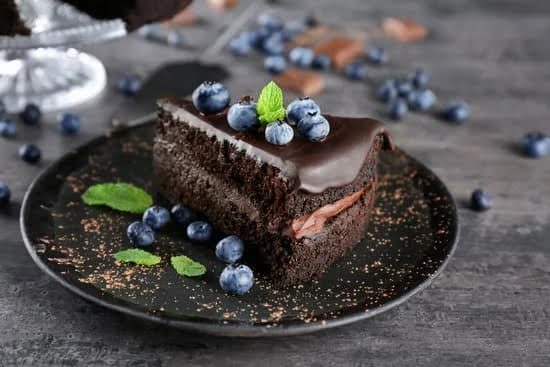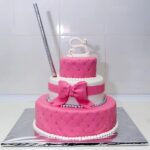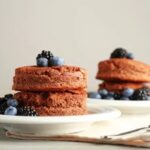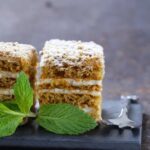Imagine a cake decorated with rich, savory baked beans – a truly unconventional twist in the world of cake decorating. Baked bean cake decorating is an emerging trend that showcases the unique and creative possibilities of turning cakes into edible works of art. With its unexpected combination of flavors, textures, and colors, this trend has captured the imagination of bakers and dessert enthusiasts around the world.
In this article, we will delve into the fascinating world of baked bean cake decorating. From its history and origin to getting started with this style, we will explore every aspect of this quirky and fun trend. Whether you are a seasoned baker or just starting out, there is something for everyone in this exciting exploration.
What sets baked bean cake decorating apart is its ability to blend the worlds of savory and sweet. This juxtaposition creates a visually stunning masterpiece that offers an unexpected culinary experience for those willing to embrace it. So get ready to step outside the traditional boundaries of cake decoration and embark on a delightful journey filled with creativity and flavor-rich surprises.
History and Origin of Baked Bean Cake Decorating
Baked bean cake decorating is not your typical cake decorating style. It is unique, creative, and has gained popularity in recent years. However, the origins of this unconventional trend are somewhat mysterious.
The Origins
The exact origins of baked bean cake decorating are difficult to trace back. This unusual style seems to have emerged from the inventive minds of bakers who wanted to experiment with new and unexpected designs. While some speculate that it may have started as a playful accident, others believe it was intentionally created by a chef looking for something bold and different.
Evolution and Cultural Significance
Over the years, baked bean cake decorating has evolved from being a quirky trend to an art form in its own right. As more bakers experimented with this style, it began gaining attention on social media platforms and in baking communities worldwide. The hashtag #bakedbeancakedecorating has become popular on Instagram, showcasing countless stunning creations.
While baked bean cake decorating does not hold any particular cultural significance, it represents an innovative approach to cake decoration and encourages individuals to think outside the box when it comes to their culinary creations.
As this trend continues to evolve, bakers around the world are incorporating elements of their own culture into their baked bean cake designs. From using traditional colors and patterns to incorporating local flavors into the frosting or filling, there is no limit to the creativity that can be expressed through this unique decorating style.
Getting Started
Preparing the Cake
To get started with baked bean cake decorating, it’s essential to have a well-prepared cake as your canvas. While you can use any type of cake recipe for this style, it’s important to choose a flavor that complements the unique and savory element of the baked bean decorations. A rich chocolate or vanilla cake is usually a safe bet, but feel free to experiment with different flavors to suit your preferences.
Once you’ve decided on a recipe, follow these steps to prepare the cake:
- Gather all the ingredients listed in the recipe.
- Preheat your oven and prepare your baking pans by greasing them or lining them with parchment paper.
- Mix the dry ingredients together in one bowl and the wet ingredients in another.
- Gradually add the dry ingredients to the wet ingredients, mixing until just combined.
- Pour the batter into your prepared pans and smooth out the tops with a spatula.
- Bake according to the recipe instructions and let the cakes cool completely before starting on the decorating process.
Assembling Your Tools and Ingredients
Before you dive into baked bean cake decorating, make sure you have all of the necessary tools and ingredients on hand. Here are some essentials to gather:
Tools:
- Piping bags: These will be used for creating intricate designs and creating texture on your cake.
- Piping tips: Choose tips that are appropriate for creating small details or larger bean-like shapes.
- Offset spatula: This tool will come in handy for smoothing buttercream or ganache onto your cake layers.
- Cake turntable: A turntable makes it easier to rotate your cake while applying frosting or decorations.
- Angled palette knife: This tool is useful for spreading frosting evenly across your cake’s surface.
Ingredients:
- Buttercream frosting: This will serve as both an adhesive for your decorations and as a base layer of frosting on your cake.
- Baked bean decorations: Decide how you want to create your baked beans, whether it’s piping them out of frosting or molding them out of fondant or marzipan.
- Food coloring: If you want to add a touch of color to your baked beans, choose food coloring gels that will provide vibrant shades without thinning out your buttercream.
For a quirky twist on the traditional tools and ingredients, consider using unconventional materials such as actual baked beans (thoroughly cleaned and prepared) or chocolate-covered coffee beans for a different texture and flavor profile in your decorating.
Applying the Buttercream Base Layer
Before you can start adding baked bean decorations to your cake, it’s important to apply a smooth base layer of buttercream frosting. This will ensure that the finished cake has an even surface and provides a good foundation for your decorations.
To apply the buttercream base layer:
- Place one cake layer on a cake board or serving plate. If desired, level the top of the cake with a serrated knife to create an even surface.
- Add a dollop of buttercream onto the center of the cake layer and spread it evenly with an offset spatula.
- Place the second cake layer on top, making sure it is aligned with the bottom layer.
- Apply another dollop of buttercream on top of the second layer and spread it evenly across the entire surface of both layers.
- Use an angled palette knife to smooth out any imperfections in the frosting, creating a clean and even base layer.
Once your base layer is complete, you are ready to begin applying your baked bean decorations onto the cake. The next section will introduce various techniques for creating these unique and eye-catching designs.
Tools and Ingredients
In order to achieve the perfect baked bean cake decorations, it is important to have the right tools and ingredients. Here is a list of essential items that you will need for this unique cake decorating style:
- Cake: The base of your baked bean cake can be any flavor or type that you prefer. However, it is recommended to choose a sturdy cake recipe that can hold up well under the weight and moisture of the decorations.
- Buttercream or Fondant: Both buttercream and fondant can be used for decorating a baked bean cake. Buttercream provides a softer, more rustic look, while fondant allows for sharper and more precise designs.
- Piping bags and tips: These are necessary for creating the bean shapes on your cake. Depending on the size and shape you want to achieve, different piping tips can be used.
- Food coloring: To give your beans their traditional brown color, you will need brown food coloring gel or paste. Additionally, you may also want other colors to create decorative elements such as leaves or flowers.
- Molding tools: These tools are useful for shaping the beans and adding details to your decorations. You can use small silicone molds or simply shape the beans by hand using your fingers or utensils like spoons and knives.
- Edible markers or paints: These will come in handy when adding small details or writing messages on your baked bean decorations.
- Optional Ingredients for added flair: While not traditional, you can experiment with additional ingredients such as edible glitter, sprinkles, or crushed nuts to add texture and visual interest to your baked bean cakes.
| Tools | Ingredients |
|---|---|
| Piping bags | Cake |
| Piping tips | Buttercream or Fondant |
| Molding tools | Brown food coloring gel/paste |
| Edible markers/paints | Optional: Edible glitter, sprinkles, crushed nuts |
Remember that while these tools and ingredients are essential, part of the creativity in baked bean cake decorating is thinking outside the box. Don’t be afraid to experiment with alternative materials or adapt the techniques to suit your own style and imagination. Enjoy the process, have fun, and let your artistic side shine through.
Decorating Techniques
In the world of baked bean cake decorating, there are a multitude of techniques that can be utilized to create unique and stunning designs. The key to successful decoration lies in mastering these techniques and being able to execute them with precision and creativity.
One popular technique for creating baked bean inspired decorations is piping. To achieve this, start by preparing a batch of buttercream frosting or royal icing in your desired colors. Fill a piping bag fitted with a small round tip with the frosting and begin by outlining the shape of a baked bean on the cake surface.
Once the outline is complete, fill in the shape using zigzag motions to mimic the texture of a real baked bean. Repeat this process with different sizes and colors to create depth and variety.
Another technique that can be used to enhance your baked bean cake design is molding. This technique involves shaping fondant or modeling chocolate into different bean shapes and textures. Start by kneading the fondant until it becomes pliable and smooth.
Then, roll out small portions of fondant into thin sheets. Use cookie cutters or a knife to cut out various shapes resembling beans. To add texture, use an edible food coloring spray or paintbrush dipped in food coloring to create spots or streaks on the beans.
For those looking for a more three-dimensional element, consider using modeling chocolate or marzipan to sculpt realistic beans that can stand on their own or be placed around the cake as accents. Shape small pieces of chocolate or marzipan into oval shapes and use your fingers to pinch one end slightly for a curved effect.
The possibilities for decorating techniques are truly endless when it comes to baked bean cake decorating. Don’t be afraid to experiment with different tools such as stencils, brushes, or even airbrushing equipment to add more depth and complexity to your designs.
Remember, practice makes perfect, so don’t get discouraged if your first attempts don’t turn out exactly as planned. With time and patience, you’ll be able to master these techniques and create stunning baked bean cake decorations that will impress and delight your friends and family.
Baked Bean Cake Ideas
When it comes to baked bean cake decorating, the possibilities are truly endless. From simple and subtle designs to elaborate and eye-catching creations, there is something for everyone to enjoy. Here are some unique and inspiring ideas to get you started on your own baked bean cake masterpieces.
- Classic Baked Bean Design: The classic baked bean design is a staple in this decorating trend. Start with a round cake and cover it with a layer of white or beige frosting to resemble the base of a plate. Then, use brown or black frosting to create the baked beans on top.
You can either pipe small dollops of frosting or use a small spoon to carefully shape the beans. Add some green sprinkles or crushed pistachios for an extra touch of realism. - Baked Bean Can Cake: For a fun twist, why not turn your cake into a giant baked bean can? Bake two rectangular cakes and stack them on top of each other, using frosting in between as glue.
Cover the entire cake with silver fondant or gray buttercream frosting to mimic the look of an aluminum can. Then, use red icing or colored fondant to create the label and add details such as nutritional information or branding logos. - Baked Bean Dinner Party Cake: If you’re feeling adventurous, take your baked bean cake decorating skills to the next level by creating an entire dinner party scene on top of your cake. Start with a larger-sized rectangular cake as your canvas and decorate it with elements like mashed potato frosting, vegetable-shaped fondant accents, and even mini sausage rolls made from rolled-up pieces of chocolate-covered biscuits.
Remember, these are just a few ideas to spark your creativity. Feel free to mix and match techniques, flavors, and decorations to bring your own unique vision to life. With baked bean cake decorating, there are no rules – only delicious possibilities waiting for you to explore.
Tips and Tricks
Baked Bean Cake Decorating is a unique and unconventional style that allows for endless creativity. However, achieving professional-looking baked bean cake decorations can be challenging. In this section, we will provide you with some essential tips and tricks to help you master this decorating technique.
- Piping consistency: When working with the “baked beans” frosting, it is crucial to achieve the right piping consistency. Too stiff, and the beans may not hold their shape; too soft, and they may spread too much. It is recommended to start with a medium consistency frosting and adjust as needed. To test the consistency, try piping a small amount onto parchment paper and observe if it holds its shape without spreading.
- Texture variation: To add depth and realism to your baked bean decorations, consider varying the texture of the beans. Use different piping tips or techniques to create beans of various sizes and shapes. Additionally, you can experiment with adding small details like cracks or speckles on some of the beans using food coloring or edible powders for an extra touch of authenticity.
- Color selection: While traditional baked beans are brownish in color, don’t be afraid to play around with different shades and variations. Consider incorporating hues like red or orange for a more vibrant look or even experimenting with black or purple for a whimsical twist. Remember to use gel food coloring instead of liquid ones to avoid altering the consistency of the frosting.
| Tips | Tricks |
|---|---|
| Piping Consistency: | Achieve medium consistency frosting |
| Texture Variation: | Create different sizes and shapes |
| Color Selection: | Experiment with various shades and hues |
By following these tips and tricks, you can enhance your skills in baked bean cake decorating and create visually stunning cakes that are sure to impress. Don’t be afraid to get creative and think outside the box when it comes to this unique style. With practice and a little bit of patience, you will be able to achieve professional-looking baked bean cake decorations that will wow your family, friends, and guests.
Baked Bean Cake Decorating for Special Occasions
Baked bean cake decorating is not just limited to everyday occasions, but can also be a delightful addition to special events and celebrations. From birthdays to Halloween parties and game nights, incorporating baked bean cake decorating can add a unique touch to any themed cake. Here are some fun ideas and inspiration for using this creative technique for specific occasions:
- Birthdays: Baked bean cake decorations can be a whimsical and unexpected addition to birthday cakes. Create a colorful bean pattern on top of the cake or use individually sculpted baked beans as cake toppers. For a playful twist, consider baking mini bean-shaped cupcakes that can be arranged in the shape of the celebrant’s age.
- Halloween: Embrace the spooky spirit of Halloween with baked bean cakes decorated in eerie themes. Use black food coloring to create a dark base for your cake and create ghost, bat, or spiderweb patterns with white icing or fondant beans. To really make an impression, mold edible “worms” from chocolate or marzipan icing and let them crawl around the sides of the cake.
- Game Nights: A baked bean cake can be the perfect centerpiece for a game night gathering with friends or family. Decorate your cake with edible playing cards made from rolled fondant or kneaded gum paste in vibrant colors. Alternatively, pipe edible dice or poker chips onto the surface of your cake for a casino-themed look.
When decorating cakes for special occasions using baked beans as inspiration, don’t be afraid to think outside the box and experiment with different shapes, colors, and toppings. The key is to have fun and let your creativity flow.
Remember: whether it’s a birthday celebration, Halloween party, or game night extravaganza – incorporating baked bean cake decorating into your special occasion will surely impress your guests and provide an unforgettable experience.
Overall, experimenting with this unique cake decorating style allows you to showcase your creativity and create a cake that stands out from the crowd. So, next time you’re planning an event or celebration, consider adding some baked bean flair to your cakes for a memorable and delicious treat.
Conclusion
In conclusion, baked bean cake decorating is a truly unique and creative trend that allows bakers to showcase their imagination and culinary skills in a fun and unconventional way.
This article has explored the history and origins of this decorating style, provided a step-by-step guide on getting started, listed the essential tools and ingredients needed, showcased various techniques for creating baked bean inspired decorations, presented numerous cake design ideas, offered expert tips and tricks to achieve professional-looking results, and discussed the possibilities of incorporating baked bean cake decorating for special occasions.
Overall, baked bean cake decorating offers a delightful twist to traditional cake decoration methods. The unusual combination of savory beans with sweet cakes provides an unexpected flavor contrast that can surprise and delight anyone who tries it. As this trend continues to evolve, we can expect even more innovative variations and designs to emerge.
We encourage our readers to embrace their creativity and give this unique cake decorating method a try. Whether you’re baking for a special occasion or simply looking to add some whimsy to your dessert table, baked bean cake decorating is sure to leave an unforgettable impression.
So go ahead and let your imagination run wild as you experiment with different flavors, techniques, and designs. With baked bean cakes as your canvas, there are no limits to what you can create.
Frequently Asked Questions
How do you spruce up baked beans?
Baked beans are a classic comfort food, and there are several simple ways to spruce them up and elevate their flavor profile. One way is to add some diced bacon or pancetta while cooking the beans, which imparts a smoky and savory taste. Another option is to incorporate spices like paprika, cumin, or chili powder for an extra kick.
Some people also enjoy adding a touch of sweetness by including brown sugar, molasses, or maple syrup. Adding finely chopped onions or garlic can provide additional depth of flavor. Ultimately, experimenting with various herbs, spices, and seasonings allows you to customize baked beans to your personal taste preferences.
What is the difference between British baked beans and American baked beans?
The main difference between British and American baked beans lies in their composition and flavor profile. British baked beans are typically made with haricot (navy) beans coated in a rich tomato sauce that is tangy-sweet in taste. On the other hand, American-style baked beans often consist of navy or kidney beans cooked in a thicker sauce that leans more towards being sweet and savory with the addition of ingredients such as brown sugar, molasses, mustard, and sometimes even bacon or other meats.
British baked beans tend to have a smoother texture compared to their American counterparts. The cultural variations in seasoning and sauce composition contribute to the distinct tastes between these two types of baked beans.
Are Heinz baked beans OK for diabetics?
Heinz baked beans can be suitable for individuals with diabetes but should still be consumed with caution due to the presence of added sugars in their recipe. While Heinz offers reduced-sugar versions of their baked beans that may be more diabetes-friendly than their regular counterparts since they contain less sugar per serving, it’s important for diabetics to carefully monitor their overall carbohydrate intake from all food sources, including those labeled as “diabetic-friendly.”
It’s always best for people with diabetes to consult their healthcare provider or registered dietitian for personalized advice on meal planning and managing blood sugar levels effectively.

Welcome to our cake decorating blog! My name is Destiny Flores, and I am the proud owner of a cake decorating business named Cake Karma. Our mission is to provide delicious, beautiful cakes for all occasions. We specialize in creating custom cakes that are tailored specifically to each customer’s individual needs and tastes.





